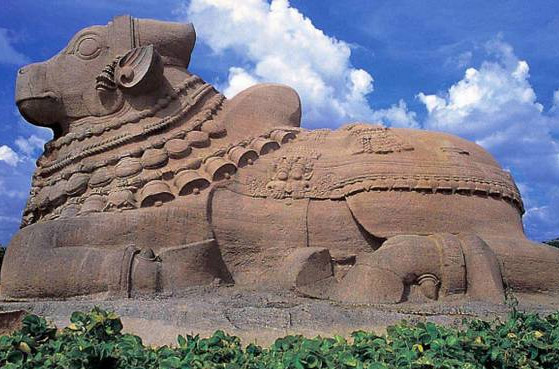 Location: 35 Km away from Penukonda, Anantapur district in Andhra Pradesh
Location: 35 Km away from Penukonda, Anantapur district in Andhra Pradesh
Dedicated to: Lord Shiva
Year of Establishment: 1530 (16th century)
Established by: Viranna and Virupanna Nayaka during the reign of Achutaraya who were Governors in the Vijayanagar Empire
Significance: The miraculous hanging pillar is of special significance in the temple
Architecture: Dravidian architecture
Road route: Cabs and buses are available from Hindupur or Bangalore to the temple. The roads on either side of the road while travelling to the temple look beautiful embellished with Sunflowers.
Rail route: The nearest railway station to the temple is the Hindupur which is 19 km away from Lepakshi village. One can easily get cabs for travelling to Lepakshi from Hindupur railway station.
Air route: Nearest airport is Bangalore which is around 130 km from Lepakshi. You can hire a cab for reaching to the temple from the Bangalore airport.
The Lepakshi temple is also known with the name "Veerbhadra temple"!! This temple is among one of the treasures of the rich history of India. It is located in Lepakshi, a small village located in Anantapur district of Andhra Pradesh. This epitome of the artistic showpiece and creation is an example of the great work of Indian architects that have existed in the past. A huge number of art pieces of astounding hanging pillars and the presence of the cave where saint Agasthya has believed to live makes this temple an exemplary piece.
Also, the Hindu scriptures and other well-established writings state that the place where the temple has been established has the foot-prints of Goddess Sita. You can have a look at the history of the Vijayanagara kingdom from the images available on walls of the temple. The temple has a great archeological importance with the pictorial representation of the various musicians, saints and Gods including that of Lord Shiva and Goddess Parvati. According to the Skanda Purana, the Lepakshi Temple is of great importance as a pilgrimage of Lord Shiva.
The temple has been divided into three sections, the assembly hall or "Mukha Mandapa", the anti-chamber or "Arda Mandapa" and the Sanctum Sanctorum or "Garbhagriha".
The walls and the pillars of the temples have the images of various dances, musicians, guardians and saints of that time and also of the 14 incarnations of Lord Shiva. The depictions of the pictures of Krishna and Rama from Mahabharata, Ramayana and have been done using bright colours. The temple's mural on the ceiling of the temple is the biggest and it has a measurement of 23 by 13 feet and it has the representation of the 14 incarnations of God Shiva. All of these paintings depict the artistic creation of Vijayanagara. The perfect blend of colours depicted therein with the artistic creation looks awe-inspiring on the walls of the temple.
Sanctums' entrance has the figurine of Goddess Yamuna and Ganga! Also, the external walls of the temple's hall are beautifully embellished with the carvings of the horses and the soldiers. In the Northeastern part of the temple there are images of Brahama, Nataraja and also the images of drummers. Also, the Southern hall of the temple has the carvings of Parvati along with her attendants. There is a gigantic image of Veerbhdra embellished with skulls! It is believed that sage Agasthya had incorporated the image of Linga in the temple. There is also the painting of the builders of the temple, Viranna and Virupanna. In the Eastern part of the temple there is the pictures of Lord Shiva and Parvati.
As per the records, a British engineer tried to displace the miraculous hanging pillar of the temple in order to find out the secret underlying the existence of this miraculous but he was not successful in doing so. Stories goes like, Virupanna who was one of the financiers of the temple was accused of drawing funds from the treasures of the kings for building the temple. He was believed to be the treasurer of the King!! The nobles of the court were very much angry that the king is allotting funds for the temple to prove his grandeur. Out of anger the king in turn order to make Virupanna blind. In order to prove his innocence Virupanna took out his eyes from the body and hurled them onto the walls of the temple.
Some of the Key attractions of the Lepakshi Temple1. The Hanging Pillar: The most astounding thing that is worth seeing about the temple is the hanging pillar. This pillar actually does not rest on the ground and it hangs in the air such that there is some space between the pillar and the ground as much as a piece of paper can be accommodated into it. This pillar is one of the miraculous pieces of engineering by the people of the time out of all the 70 pillars. Also, the archeological survey of India has proved that this pillar was made not built as a coincidence but it was built intentionally by the people of the time to prove the brilliance of the engineers and the builders of the time.
2. Lepakshi Saree Designs: Here, at this beautiful temple, there are beautiful carvings and designs of Sarees depicted on the pillars of the temples. This brilliance of creativity is the testimony of the builders of the times.
3. Naglinga: The Naglinga of this temple is the biggest of all the Monolithic Nagalinga in India. It is often said that this Naglinga was built in just in one hour while lunch for the sculptures was being prepared.
4. Durga Padam: This is the footprint of Goddess Sita! It is the Durga Padam which makes the place even more pious that attracts hundreds of devotees from across the country.